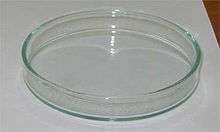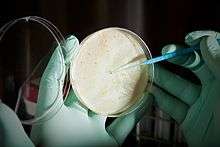Petri dish


A Petri dish (sometimes spelled "Petrie dish" and alternatively known as a Petri plate or cell-culture dish), named after the German bacteriologist Julius Richard Petri,[1][2] is a shallow cylindrical glass or plastic lidded dish that biologists use to culture cells[3] – such as bacteria – or small mosses.[4]
Modern Petri dishes usually feature rings and/or slots on their lids and bases so that when stacked, they are less prone to sliding off one another. Multiple dishes can also be incorporated into one plastic container to create a "multi-well plate". While glass Petri dishes may be reused after sterilization (via an autoclave or one hour's dry-heating in a hot-air oven at 160 °C, for example), plastic Petri dishes are often disposed of after experiments where cultures might contaminate each other.
Microbiology

Petri dishes are often used to make agar plates for microbiology studies. The dish is partially filled with warm liquid containing agar and a mixture of specific ingredients that may include nutrients, blood, salts, carbohydrates, dyes, indicators, amino acids or antibiotics. Once the agar cools and solidifies, the dish is ready to be inoculated ("plated") with a microbe-laden sample. Virus or phage cultures require a two-stage inoculation: after the agar preparation, bacteria are grown in the dish to provide hosts for the viral inoculum.
Petri plates are incubated upside-down to lessen the risk of contamination from airborne particles settling on them and to prevent the accumulation of any water condensation that may otherwise disturb or compromise a culture.
While Petri dishes are widespread in microbiological research, smaller dishes tend to be used for large-scale studies in which growing cells in Petri dishes can be relatively expensive and labor-intensive.[5][6]
Other uses
Petri dishes are also used for eukaryotic cell culture in a liquid medium or on solid agar. Empty Petri dishes may be used to observe plant germination, the behavior of very small animals or for other day-to-day laboratory practices such as drying fluids in an oven and carrying or storing samples. Their transparency and flat profile also mean they are commonly used as temporary receptacles for viewing samples, especially liquids, under a low-power microscope.
Notes and references
- ↑ Petri dish in the American Heritage Dictionary.
- ↑ Petri, R. J. (1887) "Eine kleine Modification des Koch'schen Plattenverfahrens" (A small modification of Koch's plate method), Centralblatt für Bakteriologie und Parasitenkunde, 1 : 279–280.
- ↑ Mosby's Dental Dictionary (2nd ed.). Elsevier. 2008. Retrieved 2010-02-11.
- ↑ Reski, Ralf (1998). "Development, genetics and molecular biology of mosses" (PDF). Botanica Acta. 111: 1–15. doi:10.1111/j.1438-8677.1998.tb00670.x.
- ↑ Gilbert, P.M. (2010). "Substrate elasticity regulates skeletal muscle stem cell self-renewal in culture". Science. 329: 1078–1081. doi:10.1126/science.1191035. PMC 2929271
 . PMID 20647425.
. PMID 20647425. - ↑ Chowdhury, F. (2010). "Soft substrates promote homogeneous self-renewal of embryonic stem cells via downregulating cell-matrix tractions". PLoS ONE. 5: e15655. doi:10.1371/journal.pone.0015655. PMC 3001487
 . PMID 21179449.
. PMID 21179449.
External links
| Wikimedia Commons has media related to Petri dishes. |